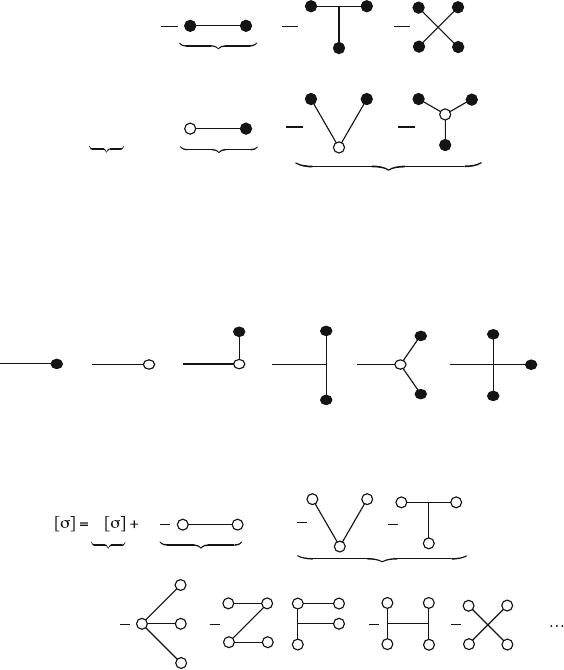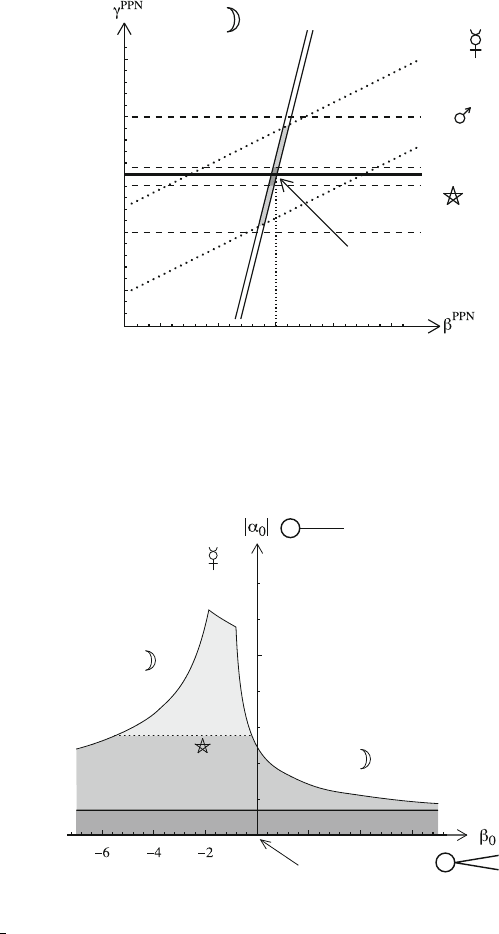Blanchet L., Spallicci A., Whiting B. (Eds.) Mass and Motion in General Relativity
Подождите немного. Документ загружается.


Motion in Alternative Theories of Gravity
Gilles Esposito-Far
`
ese
Abstract Although general relativity (GR) passes all present experimental tests
with flying colors, it remains important to study alternative theories of gravity for
several theoretical and phenomenological reasons that we recall in these lecture
notes. The various possible ways of modifying GR are presented, and we notably
show that the motion of massive bodies may be changed even if one assumes that
matter is minimally coupled to the metric as in GR. This is illustrated with the par-
ticular case of scalar-tensor theories of gravity, whose Fokker action is discussed,
and we also mention the consequences of the no-hair theorem on the motion of black
holes. The finite size of the bodies modifies their motion with respect to pointlike
particles, and we give a simple argument showing that the corresponding effects are
generically much larger in alternative theories than in GR. We also discuss possible
modifications of Newtonian dynamics (MOND) at large distances, which have been
proposed to avoid the dark matter hypothesis. We underline that all the previous
classes of alternatives to GR may a priori be used to predict such a phenomenology,
but that they generically involve several theoretical and experimental difficulties.
1 Introduction
Since general relativity (GR) is superbly consistent with all precision experimental
tests – as we will see below several examples, one may naturally ask the question:
Why should we consider alternative theories of gravity? The reason is actually three-
fold. First, it is quite instructive to contrast GR’s predictions with those of alternative
models in order to understand better which features of the theory have been exper-
imentally tested, and what new observations may allow us to test the remaining
features [36]. Second, theoretical attempts at quantizing gravity or unifying it with
other interactions generically predict the existence of partners to the graviton, that
G. Esposito-Far`ese (
)
G R"CO, Institut d’Astrophysique de Paris, UMR 7095-CNRS, Universit´e Pierre et Marie
Curie-Paris 6, 98bis boulevard Arago, F-75014 Paris, France
e-mail: gef@iap.fr
L. Blanchet, A. Spallicci, and B. Whiting (eds.), Mass and Motion in General Relativity,
Fundamental Theories of Physics 162, DOI 10.1007/978-90-481-3015-3
17,
c
Springer Science+Business Media B.V. 2011
461

462 G. Esposito-Far`ese
is, extra fields contributing to the gravitational force. This is notably the case in
all extra-dimensional (Kaluza–Klein) theories, where the components g
ab
of the
metric tensor [where a and b belong to the D 4 extra dimensions] behave as
.D 4/.D 3/=2 scalar fields (called moduli) in four dimensions. Independently
of such moduli, supersymmetry (notably needed in string theory) also implies the
existence of several fields in the graviton supermultiplet, in particular another scalar
called the dilaton. The third reason why it remains important to study alternative
theories of gravity is the existence of several puzzling experimental issues. Cosmo-
logical data are notably consistent with a Universe filled with about 72% of “dark
energy” (a fluid with negative pressure opposite to its energy density) and 24%
of “dark matter” (a fluid with negligible pressure and vanishingly small interac-
tion with ordinary matter and itself) [101,102]. Another strange phenomenon is the
anomalous extra acceleration toward the Sun that the two Pioneer spacecrafts have
undergone beyond 30 astronomical units [4,85,107](seealso[74]). Although such
issues do not threaten directly GR itself, since they may be explained by the exis-
tence of unknown “dark” fluids (or by yet unmodeled sources of noise in the case
of the Pioneer anomaly), they may nevertheless be a hint that something needs to be
changed in the gravitational law at large distances.
Since many theoretical and experimental physicists devised their own gravity
models, the field of alternative theories is much too wide for the present lecture
notes. Detailed reviews may be found in Refs. [52, 108, 113, 114]. We shall focus
here on the particular case of scalar-tensor theories and some of their generaliza-
tions. Before introducing them, let us recall that GR is based on two independent
hypotheses, which can be most conveniently described by writing its action
S D
c
3
16G
Z
d
4
x
p
gR
„
ƒ‚ …
EinsteinHilbert
CS
matter
Œmatter;g
„
ƒ‚ …
metric coupling
; (1)
where g denotes the determinant of the metric g
, R its scalar curvature, and we
use the sign conventions of Ref. [82], notably the mostly plus signature. The first
assumption of GR is that matter fields are universally and minimally coupled to one
single metric tensor g
. This ensures the “Einstein equivalence principle,” whose
consequences will be summarized in Section 2. The second hypothesis of GR is that
this metric g
propagates as a pure spin-2 field, i.e., that its kinetic term is given
by the Einstein–Hilbert action. The core of the present lecture notes, Sections 3–6,
will be devoted to the observational consequences of other possible kinetic terms.
2 Modifying the Matter Action
In the above action (1), square brackets in S
matter
Œmatter;g
mean a functional de-
pendence on the fields, that is, it also depends on their first derivatives. For instance,
the action of a point particle,

Motion in Alternative Theories of Gravity 463
S
point particle
D
Z
mc ds D
Z
mc
q
g
.x/ v
v
dt; (2)
depends not only on its spacetime position x but also on its 4-velocity v
dx
=dt. Since the matter action defines the motion of matter in a given metric g
,
it is a priori what needs to be modified with respect to GR in order to predict differ-
ent trajectories. This idea has been studied in depth by Milgrom in [80,81], where he
assumed that the action of a point particle could also depend on its acceleration and
even higher time derivatives: S
pp
.x; v; a;
P
a;:::/. However, any modification with
respect to action (2) is tightly constrained experimentally for usual accelerations,
notably by high-precision tests of special relativity. On the other hand, physics may
happen to differ for tiny accelerations, much smaller than the Earth’s gravitational
attraction. In such a case, the mathematical consistency of the theory may be in-
voked to restrict the space of allowed theories. A theorem derived by Ostrogradski
in 1850 [88,117] shows notably that the Hamiltonian is generically unbounded from
below if S
pp
.x; v; a;:::;d
n
x=dt
n
/ depends on a finite number of time derivatives,
and therefore that the theory is unstable. A possible solution would thus be to con-
sider nonlocal theories, depending on a infinite number of time derivatives. This
is actually what Milgrom found to be necessary in order to recover the Newtonian
limit and satisfy Galileo invariance. Although nonlocal theories are worth studying,
and are actually obtained as effective models of string theory, their phenomenology
is quite difficult to analyze, and we will not consider them any longer in the present
lecture notes. General discussions and specific models may be found for instance in
[49,50,80, 99,100].
Another possible modification of the matter action S
matter
Œmatter;g
is actually
predicted by string theory: Different matter fields are coupled to different metric ten-
sors, and the action takes thus the form S
matter
Œmatter
.i/
;g
.i/
. In other words, two
different bodies a priori do not feel the same geometry, and their accelerations may
differ both in norm and direction. However, the universality of free fall is extremely
well tested experimentally, as well as the three other observational consequences of
ametriccouplingS
matter
Œmatter;g
, that we will recall below. The conclusion is
that string theory must actually show that the different metrics g
.i/
are almost equal
to each other. One possible reason is that their differences may be mediated by mas-
sive fields, and would become thus exponentially small at large enough distances.
But even in presence of massless fields contributing to the difference between the
various g
.i/
, a generic mechanism has been shown to attract the theory toward GR
during the cosmological expansion of the Universe [45,47,48].
Let us now recall the four observational consequences of a metric coupling
S
matter
Œmatter;g
, as well as their best experimental verifications. If all matter
fields feel the same metric g
, it is possible to define a “Fermi coordinate system”
along any worldline, such that the metric takes the diagonal form diag.1; 1; 1; 1/
and its first derivatives vanish. In other words, up to small tidal effects proportional
to the spatial distance to the worldline, everything behaves as in special relativity.
This is the mathematically well-defined notion of a freely falling elevator. The ef-
facement of gravity in this coordinate system implies that (i) all coupling constants
464 G. Esposito-Far`ese
and mass scales of the Standard Model of particle physics are indeed space and
time independent. One of the best experimental confirmations is the time inde-
pendence of the fine-structure constant, jP˛=˛j <7 10
17
year
1
, six orders of
magnitude smaller than the inverse age of the Universe [38,59, 98]. A second con-
sequence of the validity of special relativity within the freely falling elevator is that
(ii) local (nongravitational)experiments are Lorentz invariant. The isotropy of space
has notably been tested at the 10
27
level in [34, 75, 89]. The third consequence of
a metric coupling is the very existence of this freely falling elevator where gravity
is effaced, that is, (iii) the universality of free fall: (non self-gravitating) bodies fall
with the same acceleration in an external gravitational field. This has been tested
at a few parts in 10
13
both in laboratory experiments [2, 9], and by studying the
relative acceleration of the Earth and the Moon toward the Sun [116]. The fourth
consequence of a metric coupling is (iv) the universality of gravitational redshift. It
may be understood intuitively by invoking the equivalence between the physics in
a gravitational field and within an accelerated rocket: The classical Doppler effect
suffices to show that clocks at the two ends of the rocket do not tick at the same
rate, and one can immediately deduce that lower clocks are slower in a gravitational
field. More precisely, a metric coupling implies that in a static Newtonian potential
g
00
D1 C 2U.x/=c
2
C O.1=c
4
/, the proper times measured by two clocks is
such that
1
=
2
D 1 C ŒU.x
1
/ U.x
2
/ =c
2
C O.1=c
4
/. This has been tested at the
2 10
4
level 30 years ago by flying a hydrogen maser clock [109, 110], and the
planned Pharao/Aces mission [92] should increase the precision by two orders of
magnitude.
In conclusion, the four consequences of a metric coupling have been very well
tested experimentally, notably the universality of free fall (i.e., the relative motion
of massive bodies in a gravitational field). Therefore, although theoretical con-
siderations let us expect that the Einstein equivalence principle is violated at a
fundamental level, we do know that deviations from GR are beyond present experi-
mental accuracy. In the following, we will thus restrict our discussion to theories that
satisfy exactly this principle, that is, which assume the matter action takes the form
S
matter
Œmatter;g
. On the other hand, we will now assume that the kinetic term of
the gravitational field, say S
gravity
, is not necessarily given by the Einstein–Hilbert
action of Eq. 1.
3 Modified Motion in Metric Theories?
For a given background metric g
, the kinetic term S
gravity
defines how gravita-
tional waves propagate, and the matter action S
matter
how massive bodies move in
spacetime. If we assume a universal metric coupling S
matter
Œmatter;g
as in GR,
we are thus tempted to conclude that the motion of matter must be strictly the same
as in GR, and that the present lecture notes should stop here. However, S
gravity
also
defines how g
is generated by the matter distribution. Therefore, the motion of
massive bodies within this metric does actually depend directly on the dynamics of
gravity!

Motion in Alternative Theories of Gravity 465
The clearest way to illustrate this conclusion is to integrate away the metric ten-
sor, that is, to replace it in terms of its material sources, in order to construct the
so-called Fokker action. We give below a schematic derivation of its expression,
taken from [41]. Gauge-fixing subtleties are discussed notably in Appendix C of
[46]. We start from an action of the form
S D S
˚
Œ˚ C S
matter
Œ; ˚; (3)
where ˚ denotes globally all fields participating in the gravitational interaction, and
denotes the matter sources. We also denote as
N
˚Œa solution of the field equation
ıS=ı˚ D 0 for given sources . Let us now define the Fokker action
S
Fokker
ΠS
˚
N
˚Œ
C S
matter
;
N
˚Œ
; (4)
and show that it gives the correct equations of motion for matter . Indeed, its vari-
ational derivative reads
ıS
Fokker
Œ
ı
D
ıSŒ; ˚
ı
˚D
N
˚Œ
C
ıSŒ; ˚
ı˚
˚D
N
˚Œ
ı
N
˚Œ
ı
; (5)
where the second term of the right-hand side vanishes because
N
˚Œhas been chosen
as a solution of ıS=ı˚ D 0. Therefore, ıS
Fokker
Œ=ı D 0 does yield the correct
equations of motion ıSŒ; ˚ =ı D 0 for matter within the background ˚ D
N
˚Œ
it consistently generates. The most important point to notice here is that the Fokker
action (4)isnot simply given by the matter action S
matter
Œ; ˚, computed in the
consistent background ˚ D
N
˚Œ. Not only the -dependence of this background
must be taken into account when varying the Fokker action, but its definition (4)
also depends crucially on the kinetic term (and the nonlinear dynamics) of the field,
S
˚
N
˚Œ
.
To illustrate more vividly that the motion of massive bodies does depend on the
dynamics of the gravitational field(s), let us give a diagrammatic representation of
the above formal definition (4) of the Fokker action. We first introduce some sym-
bols in Fig. 1, notably white blobs for matter sources and straight lines for field
propagators. Using this notation, the original action (3) may be translated as in
Fig. 2, which actually defines the various vertices. In this figure, the numerical fac-
tors have been chosen to simplify the field equation satisfied by
N
˚Œ,whichtakes
the diagrammatic form of Fig. 3. This figure tells us how to replace any black blob
=
Propagator of the fields (Green function)
Material sources
Left-hand side of the field equations
Fields
Fig. 1 Diagrammatic representation of matter sources, fields, and their propagator

466 G. Esposito-Far`ese
S=
+ S
0
[σ] +
−
Kinetic term
of the fields
Higher vertices
Linear interaction
of matter and fields
1
2
1
3
1
4
1
2
1
3
Free bodies
+
+ …
+
+
+
+
…
Fig. 2 Diagrammatic representation of the full action (3) of the theory, expanded in powers of ˚
(black blobs). The first line corresponds to the field action S
˚
Œ˚, and the second one to the matter
action S
matter
Œ; ˚ (describing notably the matter–field interaction)
= + + + + + …
Fig. 3 Diagrammatic representation of the field equation ıS=ı˚ D 0 satisfied by
N
˚Œ
S
Fokker
S
0
(
)
+
(
+
)
+
(
+ + + +
)
+
1
2
1
3
1
2
1
3
1
2
1
2
1
4
Newton
Free bodies
1PM
2PM
Fig. 4 Diagrammatic representation of the Fokker action (4), which depends only on matter
sources (white blobs). The dumbbell diagram labeled “Newton” represents the Newtonian in-
teraction / G, together with all velocity-dependent relativistic corrections. The 3-blob diagrams
labelled “1PM” represent first post-Minkowskian corrections, that is, the
O.G
2
/ post-Newtonian
terms as well as their full velocity dependence. The 4-blob diagrams labeled “2PM” represent
second post-Minkowskian corrections / G
3
(field ˚) by a white blob (source ) plus higher corrections, in which one can again
replace iteratively black blobs by white ones plus corrections. The Fokker action (4)
is thus simply obtained by eliminating in such a way black blobs from Fig. 2,and
the result is displayed in Fig. 4. This figure clearly shows that the dynamics of the
field (i.e., the first line of Fig. 2) does contribute to that of massive bodies. Indeed,
if it had not been taken into account, the Newtonian interaction would have been
twice too large, no “T” diagram would have appeared in Fig. 4, and the numerical
coefficients of all other diagrams would have also changed.

Motion in Alternative Theories of Gravity 467
For any theory of gravity, whose field dynamics is imposed by S
gravity
, one
may now explicitly compute the diagrams entering Fig. 4. Of course, any gauge
invariance must be fixed in order to define the field propagator as the inverse of
the quadratic kinetic term (first dumbbell diagram of Fig. 2). In the case of GR,
one may for instance fix the harmonic gauge, and the first line of Fig. 4 translates
1
as the well-known Einstein–Infeld–Hoffmann action describing the interaction of
several massive bodies labelled A, B,...:
S
Fokker
D
X
A
Z
dt m
A
c
2
q
1 v
2
A
=c
2
C
1
2
X
A¤B
Z
dt
Gm
A
m
B
r
AB
h
1 C
1
2c
2
.v
2
A
C v
2
B
/
3
2c
2
.v
A
v
B
/
1
2c
2
.n
AB
v
A
/.n
AB
v
B
/ C
PPN
c
2
.v
A
v
B
/
2
i
1
2
X
B¤A¤C
Z
dt
G
2
m
A
m
B
m
C
r
AB
r
AC
c
2
.2ˇ
PPN
1/ C O
1
c
4
: (
6)
Here r
AB
denotes the (instantaneous) distance between bodies A and B, n
AB
is the
unit 3-vector pointing from B to A, v
A
is the 3-velocity of body A, and a sum over
B ¤ A ¤ C allows B and C to be the same body. The first line of Eq. 6, noted S
0
Œ
in Figs. 2 and 4, merely describes free bodies in special relativity. The second line of
Eq. 6 describes the 2-body interaction, that is, the dumbbell diagram of Fig. 4 that
we labeled “Newton.” Its lowest-order term is indeed the Newtonian gravitational
potential, and we have also displayed its first post-Newtonian (1PN) corrections,
of order O.v
2
=c
2
/. Finally, the last line of Eq. 6 corresponds to the “V” and “T”
diagrams labeled “1PM” in Fig. 4, computed here at their lowest (1PN) order.
The two coefficients ˇ
PPN
and
PPN
entering Eq. 6 are simply equal to unity in
GR. They were introduced by Eddington [51] to describe phenomenologically other
possible theories of gravity, although he did not have any specific model in mind.
It happens that the most natural alternatives to GR, scalar-tensor theories (that we
will introduce in Section 4 below), do predict different values for these two param-
eters. This comes from the fact that massive bodies can exchange scalar particles
in addition to the usual gravitons of GR. If we represent gravitons as curly lines
and scalar fields as straight lines, the diagrams contributing to the Fokker action (6)
are indeed displayed in Fig. 5. The four diagrams involving at least one scalar line
contribute to change the values of the Eddington parameters ˇ
PPN
and
PPN
. We will
give their explicit values in Eq. 9, but we refer to Ref. [41] for their derivation from
diagrammatic calculations.
Besides ˇ
PPN
and
PPN
, many other parameters may actually be introduced to
describe the most general behavior of massive bodies at the 1PN order. Under
reasonable assumptions, notably that the matter action takes the metric form
1
One needs to compute the integrals represented by the various diagrams to derive expression (6).
See Ref. [41] for explicit diagrammatic calculations.

468 G. Esposito-Far`ese
A BAB
A
BC
+
++
+
+
1
2
1
2
1
2
1
3
1
2
Fig. 5 Diagrams contributing to the N -body action (6) at 1PN order, in scalar-tensor theories of
gravity. Graviton and scalar exchanges are represented, respectively, as curly and straight lines
S
matter
Œmatter;g
and that the gravitational interaction does not involve any
specific length scale, Nordtvedt and Will [115] showed that 8 extra parameters are a
priori possible, in addition to Eddington’s ˇ
PPN
and
PPN
. However, these 8 param-
eters vanish both in GR and in scalar-tensor gravity, therefore we will not introduce
them in these lecture notes. A detailed presentation is available in the book [113].
4 Scalar-Tensor Theories of Gravity
Among alternative theories of gravity, those which involve scalar partners to the
graviton are privileged for several reasons. Not only their existence is predicted in
all extra-dimensional theories, but they also play a crucial role in modern cosmology
(in particular during the accelerated expansion phases of the Universe). They are
above all consistent field theories, with a well-posed Cauchy problem, and they
respect most of GR’s symmetries (notably conservation laws and local Lorentz in-
variance even if a subsystem is influenced by external masses). To simplify the
discussion, we will focus on models involving a single scalar field, although the
study of tensor-multi-scalar theories can also be done in great detail [39]. We will
thus consider the class of theories defined by the action [19,86,111]
S D
c
3
16G
Z
d
4
x
p
g
R
2g
@
'@
'
CS
matter
matterIg
A
2
.'/g
:
(7)
A potential V.'/ may also be considered in this action, and is actually crucial in
cosmology, but we will study here solar-system-size effects and assume that the
scalar-field mass (and other self-interactions described by V.'/) is small enough to
be negligible at this scale. The physical metric g
, to which matter is universally
coupled (and which defines thus the lengths and times measured by material rods
and clocks), is the product of the Einstein metric g
(whose kinetic term is the
Einstein–Hilbert action) and a function A
2
.'/ characterizing how matter is coupled
to the scalar field. It will be convenient to expand it around the background value '
0
of the scalar field far from any massive body, as
ln A.'/ D ln A.'
0
/ C˛
0
.' '
0
/ C
1
2
ˇ
0
.' '
0
/
2
C O.' '
0
/
3
; (8)
where ˛
0
defines the linear coupling constant of matter to scalar excitations, ˇ
0
its
quadratic coupling to two scalar lines, etc.

Motion in Alternative Theories of Gravity 469
4.1 Weak-Field Predictions
Newtonian and 1PN predictions depend only on these first two coupling constants,
˛
0
and ˇ
0
. For instance, the effective gravitational constant between two bodies is
not given by the bare constant G
entering action (7), but by G D G
.1 C ˛
2
0
/,in
which a contribution G
comes from the exchange of a (spin-2) graviton whereas
G
˛
2
0
is due to the exchange of a (spin-0) scalar field, each matter-scalar vertex
bringing a factor ˛
0
. The first line of Fig. 5 gives a diagrammatic illustration of
this sum. [Actually, the value of a gravitational constant depends on the chosen
units, and the expression G D G
.1 C ˛
2
0
/ corresponds to the “Einstein-frame”
representation used to write action (7). An extra factor A
2
0
D A.'
0
/
2
enters when
using the physical metric g
D A
2
.'/g
to define observable quantities, and
the actual gravitational constant that is measured reads G
A
2
0
.1 C ˛
2
0
/.Nosuch
extra factors A
0
enter the computation of dimensionless observable quantities, like
the Eddington parameters ˇ
PPN
and
PPN
.] Two kinds of 1PN corrections enter the
Fokker action (6): velocity-dependent terms in the 2-body interaction (first line of
Fig. 5), which involve the parameter
PPN
, and the lowest-order 3-body interactions
(second line of Fig. 5), which involve ˇ
PPN
. Diagrammatic calculations [43]ormore
standard techniques [39, 113] can be used to compute their expressions in scalar-
tensor theories:
PPN
D 1
2˛
2
0
1 C ˛
2
0
;ˇ
PPN
D 1 C
1
2
˛
0
ˇ
0
˛
0
.1 C ˛
2
0
/
2
: (9)
Here again, the factor ˛
2
0
comes from the exchange of a scalar particle between two
bodies, whereas ˛
0
ˇ
0
˛
0
comes from a scalar exchange between three bodies (cf. the
purely scalar “V” diagram of Fig. 5).
Several solar-system observations tightly constrain these 1PN parameters to be
close to 1, i.e., their general relativistic values. The main ones are Mercury’s per-
ihelion advance [96], Lunar Laser Ranging (which allows us to test the so-called
Nordtvedt effect, i.e., whether there is a difference between the Earth’s and the
Moon’s accelerations toward the Sun) [116], and experiments involving the prop-
agation of light in the curved spacetime of the solar system (by order of increasing
accuracy: radar echo delay between the Earth and Mars, light deflection measured
by Very Long Baseline Interferometry over the whole celestial sphere [97], and
time-delay variation to the Cassini spacecraft near solar conjunction [20]). These
1PN constraints are summarized in Fig. 6, and the conclusion is that GR is basically
the only theory consistent with weak-field experiments. However, when translated
in terms of the linear and quadratic coupling constants ˛
0
and ˇ
0
of matter to the
scalar field, the same solar-system constraints take the shape of Fig. 7. Therefore, the
linear coupling constant j˛
0
j must be smaller than 3 10
3
, but we do not have any
significant constraint on ˇ
0
[nor any higher-order vertex entering expansion (8)].

470 G. Esposito-Far`ese
0.996 0.998 1 1.002 1.004
0.996
0.998
1
1.002
1.004
General
relativity
Cassini
Lunar laser ranging
Mercury
perihelion shift
Mars radar
ranging
VLBI
Fig. 6 Solar-system constraints on the post-Newtonian parameters ˇ
PPN
and
PPN
. The allowed
region is the tiny intersection of the “Lunar Laser Ranging” strip with the horizontal bold line
labeled “Cassini.” General relativity, corresponding to ˇ
PPN
D
PPN
D 1, is consistent with all
tests
0246
General relativity
0.025
0.030
0.035
0.010
0.015
0.020
0.005
LLR
Perihelion
shift
VLBI
LLR
Cassini
Fig. 7 Solar-system constraints on the matter-scalar coupling function ln A.'/=A
0
D ˛
0
.'
'
0
/ C
1
2
ˇ
0
.' '
0
/
2
C The allowed region is the dark grey horizontal strip. The vertical axis
(ˇ
0
D 0) corresponds to Brans–Dicke theory [27,56,71] with a parameter 2!
BD
C3 D 1=˛
2
0
.The
horizontal axis (˛
0
D 0) corresponds to theories which are perturbatively equivalent to GR, that is,
which predict strictly no deviation from it (at any order 1=c
n
) in the weak-field conditions of the
solar system
